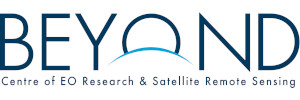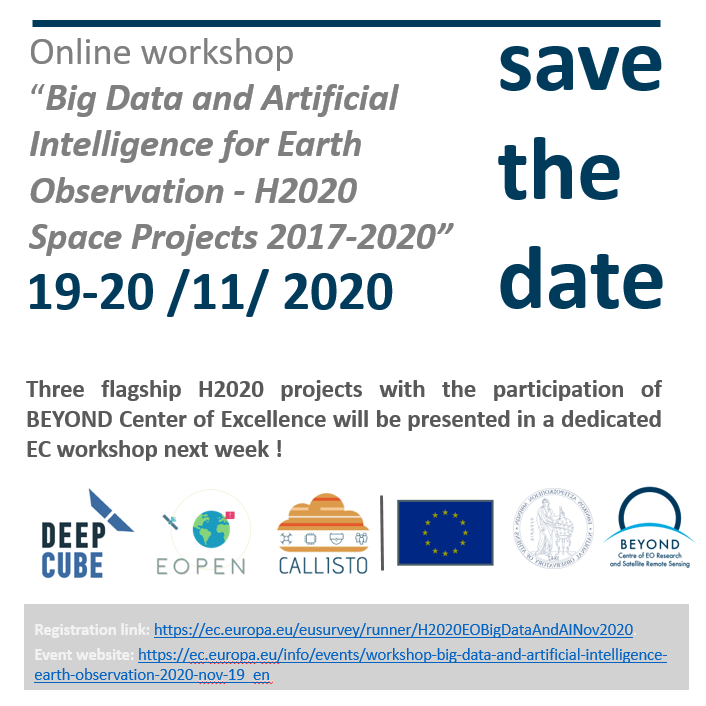We invite you to the online workshop entitled "Big Data and Artificial Intelligence for Earth Observation - H2020 Space Projects 2017-2020" on 19-20 / 11/2020. The workshop will present completed and important new projects that have received European funding from the program H2020-SPACE-2017 and H2020-SPACE-2020, see attached agenda.
To register to the workshop please follow the link https://ec.europa.eu/eusurvey/runner/H2020EOBigDataAndAINov2020.
The event website can be accessed here: https://ec.europa.eu/info/events/workshop-big-data-and-artificial-intelligence-earth-observation-2020-nov-19_en
Among others, the following three projects will be presented, in which BEYOND Center of Excellence of the National Observatory of Athens (NOA) participates. EOPEN (2017-2020) reached its conclusion In October 2020, and will present its results, while DeepCube, coordinated by BEYOND/NOA, and Callisto will kick-off on January 2021 and will run for 3 years.
- The European project "EOPEN: Open interoperable platform for unified access and analysis of Earth Observation data" will be presented. EOPEN has been recently concluded with the National Observatory of Athens holding the key role of the Scientific Management. EOPEN provides a platform targeting non-expert Earth Observation (EO) data users (non-traditional user communities), experts and the SME community that reveals and makes Copernicus data and services easy to use for Big Data applications by providing EO data analytics services, decision making and infrastructure to support the Big Data processing life-cycle allowing the chaining of value adding activities across multiple platforms. Within this context, the National Observatory of Athens has developed state-of-the-art services for accessing and searching Copernicus data, in a comprehensive and efficient fashion, through the Umbrella Sentinel Access Point. Additionally, the National Observatory of Athens has led the implementation of EOPEN's Food Security pilot, delivering a suite of services - through the use of AI algorithms and Big Data technologies, for the large scale monitoring of paddy rice in South Korea.
- DeepCube project utilizes mature and new technologies in the fields of artificial intelligence and semantic web to unlock the capabilities of the large Earth Observation data of the Copernicus program. The purpose of the project is to analyze scientific problems with a high environmental and social impact and to enhance our understanding of environmental processes. Such problems include the prediction of extreme droughts in sub-Saharan Africa, the assessment of migration flows in Africa as a consequence of climate change, the forecast of fire hazard in Mediterranean climates, the deployment of a global early warning system for volcanic eruption, the monitoring of critical infrastructure in Qatar, and the development of services to support environmentally sustainable tourism in Brazil.
- The European project "Callisto: Copernicus Artificial Intelligence (AI) Services and data fusion with other distributed data sources and processing at the edge to support DIAS and HPC infrastructures" will be presented. The National Observatory of Athens, part of the Callisto consortium, will lead Machine Learning technologies in Copernicus Data streams Work Package.CALLISTO provides a highly interoperable Big Data platform between DIAS infrastructures and Copernicus users, where the outcomes of optimized-on-HPC machine learning solutions on satellite data are semantically indexed and linked to crowdsourced, geo-referenced and distributed data sources, and served to humans in Mixed Reality environments, allowing virtual presence and situational awareness in any desired area of interest, augmented by Big Data analytics from state-of-the-art and scalable Deep Learning solutions.
In particular, the National Observatory of Athens will use Sentinel 1, Sentinel 2 data and optical imagery from a sensor mounted on a UAV to develop deep learning models for the timely monitoring of the CAP obligations. The trained models will then be loaded on the UAV to perform inference at the edge, while receiving optical imagery from the UAV at near real time.
The Agenda of the Workshop is available here.

